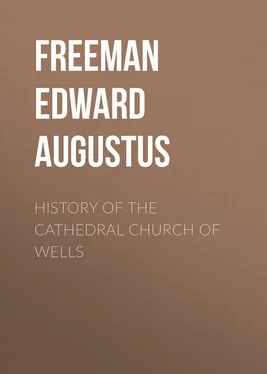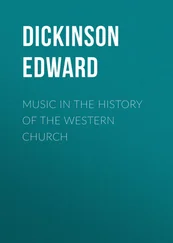Edward Freeman - History of the Cathedral Church of Wells
Здесь есть возможность читать онлайн «Edward Freeman - History of the Cathedral Church of Wells» — ознакомительный отрывок электронной книги совершенно бесплатно, а после прочтения отрывка купить полную версию. В некоторых случаях можно слушать аудио, скачать через торрент в формате fb2 и присутствует краткое содержание. Жанр: foreign_antique, foreign_prose, на английском языке. Описание произведения, (предисловие) а так же отзывы посетителей доступны на портале библиотеки ЛибКат.
- Название:History of the Cathedral Church of Wells
- Автор:
- Жанр:
- Год:неизвестен
- ISBN:нет данных
- Рейтинг книги:4 / 5. Голосов: 1
-
Избранное:Добавить в избранное
- Отзывы:
-
Ваша оценка:
- 80
- 1
- 2
- 3
- 4
- 5
History of the Cathedral Church of Wells: краткое содержание, описание и аннотация
Предлагаем к чтению аннотацию, описание, краткое содержание или предисловие (зависит от того, что написал сам автор книги «History of the Cathedral Church of Wells»). Если вы не нашли необходимую информацию о книге — напишите в комментариях, мы постараемся отыскать её.
History of the Cathedral Church of Wells — читать онлайн ознакомительный отрывок
Ниже представлен текст книги, разбитый по страницам. Система сохранения места последней прочитанной страницы, позволяет с удобством читать онлайн бесплатно книгу «History of the Cathedral Church of Wells», без необходимости каждый раз заново искать на чём Вы остановились. Поставьте закладку, и сможете в любой момент перейти на страницу, на которой закончили чтение.
Интервал:
Закладка:
Edward A. Freeman
History of the Cathedral Church of Wells / As Illustrating the History of the Cathedral Churches of / the Old Foundation
This small volume is a reprint, with hardly any change, of three lectures which were given to a local society in Wells in the months of December 1869 and January 1870, and which were printed at the time in a local paper. I have added some notes and references, but the substance is essentially the same. The subject seemed to deserve more than local attention on more grounds than one. I wished to point out the way in which local and general history may and ought to be brought together. As a general rule, local historians make hardly any attempt to connect the history of the particular church or city or district of which they are writing with the general history of the country, or even with the general history of its own class of institutions. On the other hand, more general students of history are apt to pay too little heed to the history of particular places. I have here tried to treat the history of the Church of Wells as a contribution to the general history of the Church and Kingdom of England, and specially to the history of the Cathedral Churches of the Old Foundation. I have also a special object in calling attention to the origin and history of those foundations, to their original objects and their modern corruptions. It is quite impossible that our Cathedral institutions can stay much longer in the state in which they now are, a state which satisfies no party. If they are not reformed by their friends, they can hardly fail to be destroyed by their enemies. The awkward attempt at reform which was made thirty years back was made in utter ignorance of the history and nature of the institutions. Instead of reforming them, it has merely crippled them. Our Cathedral Churches have indeed vastly improved during those thirty years; but it has been almost wholly because they have shared in a general improvement, hardly at all by virtue of the changes which were specially meant to improve them. I wish to point out the general principles of the original founders as the model to which the Old Foundations should be brought back, and the New Foundations reformed after their pattern.
What I have now written is of course a mere sketch, which does not at all pretend to be a complete history of the Church of Wells, either architectural or documentary. I had hoped that Professor Willis would have allowed me the use of the materials of both kinds on which he grounded his lectures in 1851 and 1863. But it seems that he reserves them for the general work for which architectural students have been waiting so long. I have therefore been left to my own resources, that is, as far as documents are concerned, to the ordinary printed authorities in Anglia Sacra , the Monasticon , and elsewhere. But it is to be hoped that some day or other the documents that are locked up in manuscript at Wells and at other places may be made available for historical purposes. Some of our capitular records would be excellently suited for a place in the series issued by the Master of the Rolls.
I have given an historical ground-plan, but the scale of the book forbade any strictly architectural illustrations, while it seemed needless to give any mere picturesque views of a building of which engravings and photographs are so common.
Somerleaze, Wells,
May 18th, 1870 .
LIST OF BISHOPS

1 Translated to Canterbury.
2 This seems to have been a case of disputed election.
3 Translated to Canterbury.
4 Translated to York.
5 Translated from Worcester.
6 Translated to Ely.
7 Translated from Coventry and Lichfield.
8 Translated to Durham.
9 Translated from Salisbury.
10 Translated to York.
11 Translated from London to Salisbury, and thence to Bath and Wells.
12 Translated to Canterbury.
13 Translated from Exeter.
14 Translated to Durham, thence to Winchester.
15 Translated from Exeter.
16 Translated from Hereford.
17 Deprived for a conspiracy against Pope Leo the Tenth.
18 Held in plurality with York.
19 Exchanged for Durham.
20 Translated from Saint David's.
21 Deprived on the accession of Queen Mary and reappointed to Chichester under Queen Elizabeth.
22 Deprived on the accession of Elizabeth.
23 Father of Francis Godwin the historian, Canon of Wells and afterwards Bishop of Llandaff.
24 Translated to Winchester.
25 Translated from Saint David's.
26 Translated to London and thence to Canterbury.
27 Translated from Rochester.
28 Translated to Winchester.
29 Translated from Peterborough.
30 Translated to Winchester.
31 Deprived for refusing the oaths to William and Mary.
32 Translated from Saint Asaph.
33 Translated from Saint David's.
34 Translated from Gloucester.
35 Translated from Carlisle.
36 Translated from Oxford.
37 Translated from Sodor and Man.
38 Resigned. Died 1870.
LECTURE I
The subject which I have chosen for this course of lectures is one which must always have an interest beyond all others for us who live in this city and neighbourhood. In every place which boasts of a cathedral church, that cathedral church is commonly the chief object of interest, alike as its present ornament and as the chief centre of its past history. But in Wells the cathedral church and its appurtenances are yet more. Their interest is not only primary, but absorbing. They are not only the chief ornament of the place; they are the place itself. They are not only the centre of the past history of the city; their history is the history of the city. Of our other cities some can trace up a long history as cities independent of their ecclesiastical foundations. Some were the dwelling-places of Kings in days before England became one kingdom. Some have been for ages seats of commerce or manufactures; their history is the history of burghers striving for and obtaining their freedom, a history which repeats in small that same tale of early struggles and later abuses which forms the history of so many greater commonwealths. Others have a long military history; their name at once suggests the memory of battles and sieges, and they can still show walls and castles as the living memorials of the stirring scenes of bygone times. In others even the ecclesiastical pre-eminence of the cathedral church may be disputed by some other ecclesiastical building. The bishoprick and its church may be comparatively modern institutions, and they may be altogether eclipsed by some other institution more ancient in date of foundation, perhaps more ancient in its actual fabric. Thus at Oxford the cathedral church is well-nigh lost among the buildings of the University and its greatest college. At Chester its rank may be disputed by the majestic fragments of the older minster of Saint John. At Bristol the cathedral church, even when restored to its old proportions, will still have at least an equal rival in the stateliest parish church in England. In these cities the bishoprick, its church and its chapter, are institutions of yesterday; the cities themselves were great and famous for ages before they were founded. So at Exeter, though the bishoprick is of far earlier date, yet Exeter was a famous city, which had played its part in history, long before Bishops of Exeter were heard of. Even at Winchester the overwhelming greatness of the Old Minster has to compete with the earlier and later interests of the royal palace, of the fallen Abbey, of the unique home of noble poverty 1 1 "Domus eleemosynaria nobilis paupertatis" is the style of the Hospital of Saint Cross near Winchester, as enlarged by Cardinal Beaufort. See the Licence of Incorporation in the Monasticon, vii. 724.
Интервал:
Закладка:
Похожие книги на «History of the Cathedral Church of Wells»
Представляем Вашему вниманию похожие книги на «History of the Cathedral Church of Wells» списком для выбора. Мы отобрали схожую по названию и смыслу литературу в надежде предоставить читателям больше вариантов отыскать новые, интересные, ещё непрочитанные произведения.
Обсуждение, отзывы о книге «History of the Cathedral Church of Wells» и просто собственные мнения читателей. Оставьте ваши комментарии, напишите, что Вы думаете о произведении, его смысле или главных героях. Укажите что конкретно понравилось, а что нет, и почему Вы так считаете.












